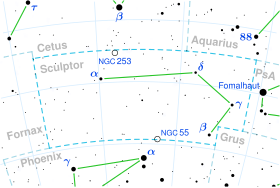| Observation data Epoch J2000 Equinox J2000 | |
|---|---|
| Constellation | Sculptor |
| Right ascension | 01h 42m 08.62230s [1] |
| Declination | −32° 19′ 37.2862″ [1] |
| Apparent magnitude (V) | 5.25 [2] |
| Characteristics | |
| Evolutionary stage | horizontal branch [3] |
| Spectral type | K1II/III [4] |
| U−B color index | +0.79 [5] |
| B−V color index | +1.05 [5] |
| Astrometry | |
| Radial velocity (Rv) | +13.83±0.15 [1] km/s |
| Proper motion (μ) |
RA: −76.714
[1]
mas/
yr Dec.: +4.521 [1] mas/ yr |
| Parallax (π) | 15.0534 ± 0.1667 mas [1] |
| Distance | 217 ± 2
ly (66.4 ± 0.7 pc) |
| Absolute magnitude (MV) | 1.16 [2] |
| Details | |
| Mass | 1.52 [3] M☉ |
| Radius | 9.28+0.30 −2.31 [1] R☉ |
| Luminosity | 41.173±0.53 [1] L☉ |
| Surface gravity (log g) | 2.69 [3] cgs |
| Temperature | 4,800+737 −75 [1] K |
| Metallicity [Fe/H] | −0.22 [3] dex |
| Rotational velocity (v sin i) | < 1.6 [6] km/s |
| Other designations | |
| Database references | |
| SIMBAD | data |
π Sculptoris, Latinized as Pi Sculptoris, is candidate astrometric binary [8] star system in the southern constellation Sculptor, positioned near the eastern constellation border with Fornax. It has an orange hue and is dimly visible to the naked eye with an apparent visual magnitude of 5.25. [2] Based upon parallax measurements, the system is located at a distance of 66 light years from the Sun, and is drifting further away with a radial velocity of +14 km/s. [1]
The visible component is an aging giant/ bright giant star with a stellar classification of K1II/III. [4] It is a red clump giant, which indicates it is on the horizontal branch and is generating energy through core helium fusion. [3] The star has 1.5 [3] times the mass of the Sun and 9.3 [1] times the Sun's radius. It is radiating 41 [1] times the luminosity of the Sun from its swollen photosphere at an effective temperature of 4,800 K. [1]
References
- ^ a b c d e f g h i j k l m Brown, A. G. A.; et al. (Gaia collaboration) (August 2018). "Gaia Data Release 2: Summary of the contents and survey properties". Astronomy & Astrophysics. 616. A1. arXiv: 1804.09365. Bibcode: 2018A&A...616A...1G. doi: 10.1051/0004-6361/201833051. Gaia DR2 record for this source at VizieR.
- ^ a b c Anderson, E.; Francis, Ch. (2012). "XHIP: An extended hipparcos compilation". Astronomy Letters. 38 (5): 331. arXiv: 1108.4971. Bibcode: 2012AstL...38..331A. doi: 10.1134/S1063773712050015. S2CID 119257644. Vizier catalog entry
- ^ a b c d e f Liu, Y. J.; et al. (2007). "The abundances of nearby red clump giants". Monthly Notices of the Royal Astronomical Society. 382 (2): 553. Bibcode: 2007MNRAS.382..553L. doi: 10.1111/j.1365-2966.2007.11852.x.
- ^ a b Houk, N. (1982). Michigan Catalogue of Two-dimensional Spectral Types for the HD stars. Declinations -40_ƒ0 to -26_ƒ0. Vol. 3. Bibcode: 1982mcts.book.....H.
- ^ a b Mermilliod, J. C. (2006). "Homogeneous Means in the UBV System". VizieR On-line Data Catalog: II/168. Originally Published in: Institut d'Astronomie. 2168. Bibcode: 2006yCat.2168....0M. Vizier catalog entry
- ^ De Medeiros, J. R.; et al. (2014). "A catalog of rotational and radial velocities for evolved stars". Astronomy & Astrophysics. 561: A126. arXiv: 1312.3474. Bibcode: 2014A&A...561A.126D. doi: 10.1051/0004-6361/201220762. S2CID 54046583. Vizier catalog entry
- ^ "pi Scl". SIMBAD. Centre de données astronomiques de Strasbourg. Retrieved 2019-10-13.
- ^ Eggleton, P. P.; Tokovinin, A. A. (September 2008). "A catalogue of multiplicity among bright stellar systems". Monthly Notices of the Royal Astronomical Society. 389 (2): 869–879. arXiv: 0806.2878. Bibcode: 2008MNRAS.389..869E. doi: 10.1111/j.1365-2966.2008.13596.x. S2CID 14878976.
